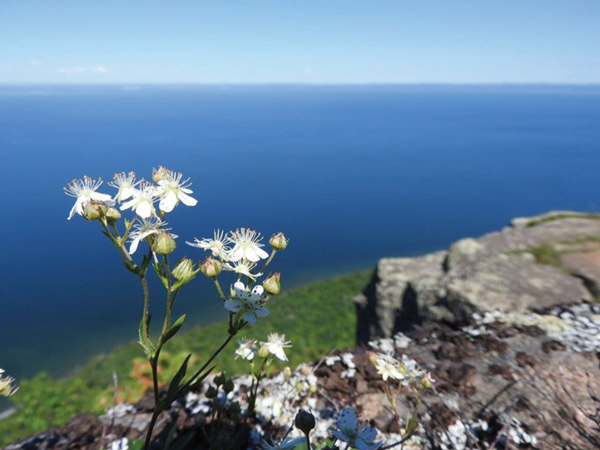Higher Plants

The view was spectacular. Hot and sweaty, we emerged from the humid forest into brilliant sunlight on top of the world. Our toes crept toward the edge of lichen-crusted rocks and our souls soared out over the deep blue waters of Lake Superior.
Hiking to the Top of the Giant, in Sleeping Giant Provincial Park in Ontario, Canada, has been on my adventure list for a while. Despite the July heat, the record month of rainfall collecting in mud puddles, and a bumper crop of bugs, it was worth the wait. Forested hills spread their welcoming embrace, craggy cliffs rose wildly from the blanket of green, and The Lake sparkled with its special magic.
After inhaling the grandeur for several moments I turned my focus downward again, perhaps seeking relief from such strenuous awe.
The world is beautiful at all scales. There at my toes were the exquisite flowers of three-toothed cinquefoil. On each small blossom, five white petals threw themselves back like outspread arms embracing the sky, and a crowd of delicate stamens and pistils reached eagerly toward the sun. Shiny green leaves spread out in a low mat. Each leaf was palmately divided into three lobes, and each lobe was tipped by three pointed teeth.
These are the mountain men of the plant world. Three-toothed cinquefoil can’t survive on good soils where numerous neighbors crowd close. Instead, they claim space where others can’t survive and dig their toes into craggy bedrock. Here they eke out a living on dust, rain, beauty, and solitude. Woody, creeping stems cling to the available footholds; thick, leathery leaves defend their precious water; and red pigments protect their winter foliage from harsh sun.
They’ve come a long way.
Just over 1.1 billion years ago, two separate events initiated this combination of rock and flower. These craggy cliffs where cinquefoil clings solidified from magma 1.1 billion years ago during the mid-continent rift event that initiated the Lake Superior basin. The continent tried to rip itself in two. Farther south, along the North Shore of Minnesota, lava erupted onto the surface. Up here in Canada, molten rock squeezed in between layers of older sedimentary rocks. The magma cooled, the rocks tilted a bit, and then the softer sedimentary rocks began to erode away. This resulted in the spectacular topography and my steep hike.
The other event happened in an ancient sea where the first cells of life swam in the primordial soup. One eukaryotic cell, now known as an archaeplastida, engulfed a free-living, photosynthetic cyanobacteria. The two single-celled organisms began living in symbiosis. Some scientists say that the eukaryote enslaved the cyanobacteria, forcing it to produce food for them both. Others acknowledge that the surrounding cell would have given the cyanobacteria a measure of protection, plus access to the sunlight, water, and carbon dioxide it needed to photosynthesize.
Eventually the two different cells began to coordinate their division (and hence their reproduction), and even trade genes. Eventually the cyanobacteria was no longer a free-living endosymbiont—it was a chloroplast—just one of the organelles in the eukaryotic cell.
Fast forward to half a billion years ago, and those plant cells containing chloroplasts developed into multicellular organisms and moved out of the sea. But the first simple land plants still needed easy access to plentiful water for both reproduction and photosynthesis.
Now, today, I can admire a beautiful flower with a woody stem clinging to a dry cliff more than a thousand feet above the freshwater sea.
The journey to this point was long and winding, but the view is truly amazing. Thinking about all this, I’m not sure that looking down was the right way to seek relief from strenuous awe.
For over 45 years, the Cable Natural History Museum has served to connect you to the Northwoods. Come visit us in Cable, WI! Our new phenology exhibit: “Nature’s Calendar: Signs of the Seasons” is now open.
Find us on the web at www.cablemuseum.org to learn more about our exhibits and programs. Discover us on Facebook, or at our blogspot, http://cablemuseumnaturalconnections.blogspot.com.
